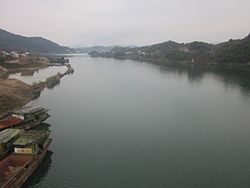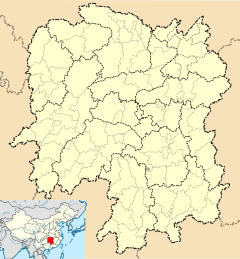
Hunan cuisine, also known as Xiang cuisine, consists of the cuisines of the Xiang River region, Dongting Lake and western Hunan Province in China. It is one of the Eight Great Traditions of Chinese cuisine and is well known for its hot and spicy flavours, fresh aroma and deep colours. Common cooking techniques include stewing, frying, pot-roasting, braising and smoking. Due to the high agricultural output of the region, ingredients for Hunan dishes are many and varied.

Hunan is a landlocked province of the People's Republic of China, part of the South Central China region. Located in the middle reaches of the Yangtze watershed, it borders the province-level divisions of Hubei to the north, Jiangxi to the east, Guangdong and Guangxi to the south, Guizhou to the west and Chongqing to the northwest. Its capital and largest city is Changsha, which also abuts the Xiang River. With a population of just over 67 million as of 2014 residing in an area of approximately 210,000 km2 (81,000 sq mi), it is China's 7th most populous province by population and the 10th most extensive province by area. Its 2018 nominal GDP was more than US$500 billion, which is among the top 30 largest sub-national economies in the world with its PPP GDP being over US$1 trillion.

Changsha, is the capital and the largest city of Hunan Province in the south central part of the People's Republic of China, located in the lower reaches of Xiang River in northeastern Hunan. Changsha is also called Xingcheng and was once named Tanzhou (潭州) in ancient times. It is also known as Shanshuizhoucheng (山水洲城), for the city, with the Xiang River flowing through it, contains Mount Yuelu and Juzi Isle geographically. Changsha, with a total population up to 10 million as of 2020, is the core city of Chang-Zhu-Tan City Cluster and a supercity in China, one of the core cities in Central China, a National Comprehensive Transportation Hub, and one of the first National Famous Historical and Cultural Cities in China. Changshanese, a kind of Xiang Chinese, is spoken in the downtown, while Ningxiangnese and Liuyangnese are also spoken in the counties and cities under its jurisdiction.

Dongting Lake is a large, shallow lake in northeastern Hunan Province, China. It is a flood basin of the Yangtze River, so its volume depends on the season. The provinces of Hubei and Hunan are named after their location relative to the lake: Hubei means "North of the Lake" and Hunan, "South of the Lake".

The Xiang River is the chief river of the Lake Dongting drainage system of the middle Yangtze, the largest river in Hunan Province, China. It is the 2nd largest tributary in terms of surface runoff, the 5th largest tributary by drainage area of the Yangtze tributaries. The river flows generally northeast through Guangxi and Hunan two provinces, its tributaries reach into Jiangxi and Guangdong.

Lishui River is a river in Hunan province of China, one of the Yangtze River's four largest tributaries in the province.

The First Battle of Changsha was the first of four attempts by Japan to take the city of Changsha, Hunan, during the second Sino-Japanese War. It was the first major battle of the war to fall within the time frame of what is widely considered World War II.

Wulingyuan is a scenic and historical site in the Wulingyuan District of South Central China's Hunan Province. It was inscribed as a UNESCO World Heritage Site in 1992. It is noted for more than 3,000 quartzite sandstone pillars and peaks across most of the site, many over 200 metres (660 ft) in height, along with many ravines and gorges with attractive streams, pools, lakes, rivers and waterfalls. It features 40 caves, many with large calcite deposits, and a natural bridge named Tianqiashengkong, which is one of the highest natural bridges in the world. The site also provides habitat for many vulnerable species, including the dhole, Asiatic black bear, and Chinese water deer.

Xiangxi Tujia and Miao Autonomous Prefecture is an autonomous prefecture of the People's Republic of China. It is located in northwestern Hunan province. It consists of one city, Jishou, and seven counties: Baojing, Fenghuang, Guzhang, Huayuan, Longshan, Luxi, Yongshun. The capital is Jishou. Twenty-five nationalities gather here, of the total 2,480,000 population, 66.6 per cent are ethnic minorities, including 860,000 Tujia and 790,000 Miao.

The Yuan River, also known by its Chinese name as the Yuanjiang, is one of the four largest rivers in Hunan province in southeast-central China. It is a tributary of Yangtze River. It is 864 kilometres (537 mi) long and rises in Guizhou province in the Miao Mountains near Duyun and is navigable. The upper stream is called the Longtou River, and downstream it is called the Qingshui or Ch‘ing-shui River. It becomes the Yuan River after its confluence with its northern tributary, the Wu River.

The Miluo River is located on the eastern bank of Dongting Lake, the largest tributary of the Xiang River in the northern Hunan Province. It is an important river in the Dongting Lake watershed, known as the location of the ritual suicide in 278 BC of Qu Yuan, a poet of Chu state during the Warring States period, in protest against the corruption of the era.

The Rise of Central China Plan is a policy adopted by the People's Republic of China to accelerate the development of its central regions. It was announced by Premier Wen Jiabao on 5 March 2004. It covers six provinces: Shanxi, Henan, Anhui, Hubei, Hunan, and Jiangxi.

The Xuefeng Mountains are a mountain range of China in western Hunan province.

Linxiang is a county-level city in Hunan province, China, it is under the administration of the prefecture-level city of Yueyang. Linxiang is located at the northeastern edge of Hunan province, on the southeastern (right) bank of the Yangtze River, which lies to the east of the city proper. Linxiang is bordered to the northwest and the north across the Yangtze by Jianli County and Honghu City of Hubei, to the east by Chibi City, Chongyang and Tongcheng Counties of Hubei, to the south and southwest by Yueyang County, to the west by Yunxi District. It covers an area of 1,718 km2 (663 sq mi), as of 2015, it had a registered population of 537,500. The city has 3 subdistricts and 10 towns under its jurisdiction. the government seat is Chang'an (长安街道).

Xiangyin County is a county in Hunan Province, China, it is under the administration of Yueyang City. Located on the southeastern shores of Lake Dongting, the Xiang River runs south to north through the middle lands of the county, the Zi River merges into Dongting in the westeastern margin. Xiangyin is bordered by Yueyang County, Yuanjiang City to the north, Heshan District of Yiyang to the west, Wangcheng District of Changsha to the south, Miluo City to the east. It has an area of 1,581.5 km2 (610.6 sq mi) with rough 770,000 of population, the county is divided into 14 township-level divisions, the county seat is Wenxing Town.

Lukou District, formerly Zhuzhou County, is a district of the city of Zhuzhou, Hunan Province, China. Located on the south central Hunan along the Xiang River, the district is bordered to the north by Liuyang City, Lusong and Tianyuan Districts, to the west by Xiangtan County, to the southwest by Hengdong County, to the southeast by You County, to the east by Liling City. Lukou covers 1,053.62 km2 (406.80 sq mi), as of 2015, it had a registered population of 348,800 and resident a population of 292,400. The district has 8 towns under its jurisdiction, the seat is at Lukou Town (渌口镇).

Shifeng District is one of four urban districts of Zhuzhou City, Hunan province, China. It is named after the Shifeng Park, which lies on the south of the district and the northern bank of the Xiang River.

Xupu County is a county of Hunan Province, China, it is under the administration of Huaihua Prefecturel-level City.

The Xiao River is the Main Stream of the upper Xiang River located in Yongzhou, Hunan. As of 2011 Water Census of China, it has a length of 365 kilometres (227 mi) from the headwaters to the confluence in the Ping Island of Yongzhou with the Xiang River West Branch originating from Guangxi. With the tributaries, its drainage basin area is 12,094 square kilometres (4,670 sq mi).

New Xiang, also known as Chang-Yi is the dominant form of Xiang Chinese. It is spoken in northeastern areas of Hunan adjacent to areas where Southwestern Mandarin and Gan are spoken. Under their influence, it has lost some of the conservative phonological characteristics that distinguish Old Xiang. While most linguists follow Yuan Jiahua in describing New Xiang as a subgroup of Xiang Chinese, Zhou Zhenhe and You Rujie classify it as Southwestern Mandarin. However, New Xiang is still very difficult for Mandarin speakers to understand, particularly the old style of New Xiang.


















